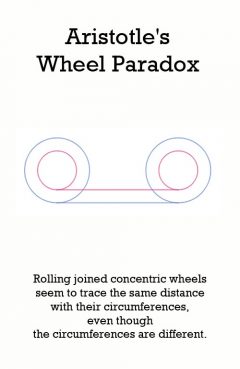Aristotle's Wheel Paradox

Release Date: //
Country of Release:
Length:
MPAA:
Medium: Paradox
Genre:
Release Message: Rolling joined concentric wheels seem to trace the same distance with their circumferences, even though the circumferences are different. Authored by Aristotle.
Description: Aristotle's wheel paradox is a paradox from the Greek work Mechanica traditionally attributed to Aristotle. There are two wheels, one within the other, whose rims take the shape of two circles with different diameters. The wheels roll without slipping for a full revolution. The paths traced by the bottoms of the wheels are straight lines, which are apparently the wheels' circumferences. But the two lines have the same length, so the wheels must have the same circumference, contradicting the assumption that they have different sizes: a paradox. The fallacy is the assumption that the smaller wheel indeed traces out its circumference, without ensuring that it, too, rolls without slipping on a fixed surface. In fact, it is impossible for both wheels to perform such motion. Physically, if two joined concentric wheels with different radii were rolled along parallel lines then at least one would slip; if a system of cogs were used to prevent slippage then the wheels would jam. A modern approximation of such an experiment is often performed by car drivers who park too close to a curb. The car's outer tire rolls without slipping on the road surface while the inner hubcap both rolls and slips across the curb; the slipping is evidenced by a screeching noise. Alternatively, the fallacy is the assumption that the smaller wheel is independent of the larger wheel. Imagine a tire as the larger wheel, and imagine the smaller wheel as the interior circumference of the tire and not as the rim. The movement of the inner circle is dependent on the larger circle. Thus its movement from any point to another can be calculated by using an inverse of their ratio.